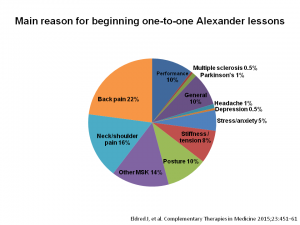I was asked the other day how it is that learning the Alexander Technique can have such a wide range of different benefits. People want to learn the Technique for all sorts of reasons, from helping manage chronic health problems through to enhancing sporting performance. A recent national research survey found that the most common reason for beginning Alexander lessons is musculoskeletal pain but there were also many other reasons (Figure).1

Click for larger view of figure
So how can one approach help across such a wide range of areas? And why is it that people may begin lessons for one reason but often then discover additional unanticipated benefits?
Learning the Alexander Technique acts at a fundamental level − enabling us to change the way in which we react, move, stand, sit etc, and so to carry out our daily activities with less effort, less stress and more poise. With the help of an Alexander Technique teacher, we can become more aware of ourselves (mind-body) and our habits, quietening an over-active mind and discovering how to have more choice over how we respond in any situation. In parallel, through the practical experience gained in one-to-one lessons, including hands-on guidance, our natural movement coordination, balance and posture are gradually restored.
It’s easy to see how something like sporting performance could improve as a result of better movement coordination and balance. Perhaps it’s less obvious how certain health problems could also be helped. Let’s take the example of someone who develops back pain. If they then continue to go about their daily activities with the same habitual ways of moving, sitting, lifting etc − all of which are likely to put extra stress and strain on their back (and which, may have contributed to the problem in the first place), then in some cases their pain may take quite a while to resolve. If, instead, they are enabled to reduce their habitual interference in their natural movement and postural patterns, then the problem will have a greater opportunity to resolve itself (through the body’s natural healing processes). And, indeed, two large randomised controlled clinical trials have demonstrated significant long-term reductions in pain and associated disability for people with chronic back or neck pain who took one-to-one Alexander lessons. Other research has reported lessons leading to a reduction in performance-related anxiety in musicians, and improvements in psychological well-being, mood and confidence.4−6
More information: back pain trial, neck pain trial, other research.
References
- Eldred J, Hopton A, Donnison E, Woodman J, MacPherson H. Teachers of the Alexander Technique in the UK and the people who take their lessons: A national cross-sectional survey. Complementary Therapies in Medicine 2015;23:451−61.
- Little P, Lewith G, Webley F, Evans M, Beattie A, Middleton K, et al. Randomised controlled trial of Alexander technique lessons, exercise, and massage (ATEAM) for chronic and recurrent back pain. British Medical Journal 2008;337:a884.
- MacPherson H, Tilbrook H, Richmond S, Woodman J, Ballard K, et al. Alexander Technique lessons or acupuncture sessions for persons with chronic neck pain: A randomized trial. Annals of Internal Medicine 2015;163:653−62.
- Armitage J. Psychological change and the Alexander Technique. Unpublished doctoral dissertation 2009, University of Hull.
- Jones T and Glover L. Exploring the psychological processes underlying touch: Lessons from the Alexander Technique. Clinical Psychology and Psychotherapy 2012;10.1002/cpp.1824.
- Klein SD, Bayard C, Wolf U. The Alexander Technique and musicians: a systematic review of controlled trials. BMC Complementary and Alternative Medicine 2014;14:414. doi: 10.1186/1472-6882-14-414.